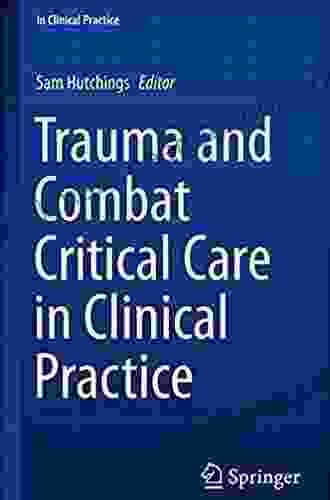Trauma and Combat Critical Care: A Comprehensive Guide for Clinical Practice

Trauma and combat critical care are specialized fields within medicine that focus on the management of severe injuries and life-threatening conditions in both civilian and military settings. Healthcare professionals working in these fields face unique challenges and require specialized knowledge and skills to effectively care for patients.
4.8 out of 5
| Language | : | English |
| File size | : | 8243 KB |
| Text-to-Speech | : | Enabled |
| Screen Reader | : | Supported |
| Enhanced typesetting | : | Enabled |
| Print length | : | 571 pages |
This article provides a comprehensive overview of trauma and combat critical care, covering the principles, practices, and challenges encountered in clinical practice. It is intended to serve as a valuable resource for healthcare professionals, including physicians, nurses, paramedics, and other allied health professionals involved in the care of trauma and combat casualties.
Principles of Trauma and Combat Critical Care
The principles of trauma and combat critical care are based on a systematic approach to patient management, emphasizing rapid assessment, stabilization, and definitive care.
1. Assessment and Triage
The initial assessment involves a rapid and focused examination to identify life-threatening injuries and prioritize treatment. Triage is the process of categorizing patients based on the severity of their injuries and determining the appropriate level of care.
Key Assessment Components:
- Airway, Breathing, and Circulation
- Neurological Exam (GCS)
- Hemorrhage Control
- Head and Neck Injuries
- Chest and Abdominal Injuries
- Extremity Injuries
2. Stabilization
Stabilization refers to the interventions aimed at correcting life-threatening conditions and preventing further deterioration. This includes:
- Oxygenation and Ventilation
- Hemorrhage Control and Fluid Resuscitation
- Pain Management and Sedation
- Hypothermia Prevention
3. Definitive Care
Definitive care involves definitive surgical and non-surgical interventions to address the underlying injuries and restore function. This may include:
- Surgical Exploration and Repair
- Intensive Care Unit Management
- Rehabilitation and Physical Therapy
Challenges in Trauma and Combat Critical Care
Trauma and combat critical care present unique challenges that require specialized knowledge and skills:
1. Complex Injury Patterns
Trauma and combat casualties often sustain multiple and complex injuries, requiring a comprehensive understanding of anatomy and physiology.
2. Time-Sensitive Decision-Making
Rapid assessment and decision-making are crucial in trauma and combat critical care, as delays can have significant consequences.
3. Scarce Resources in Battlefield Settings
In combat settings, healthcare providers may face limited resources, equipment, and supplies, necessitating improvisation and adaptability.
4. Ethical Considerations
Trauma and combat critical care raises complex ethical issues, such as triage decisions and the use of life-sustaining treatments.
Best Practices in Trauma and Combat Critical Care
To improve patient outcomes, healthcare professionals should adhere to best practices in trauma and combat critical care:
1. Advanced Trauma Life Support (ATLS)
ATLS is a standardized approach to trauma management that provides guidelines for assessment, stabilization, and definitive care.
2. Military Trauma Surgery (MTS)
MTS focuses on the management of combat-related injuries, including blast injuries, penetrating trauma, and burns.
3. Critical Care Air Transport (CCAT)
CCAT involves the rapid and efficient transport of critically ill or injured patients to specialized medical facilities.
4. Interdisciplinary Collaboration
Trauma and combat critical care requires collaboration between multiple healthcare professionals, including surgeons, physicians, nurses, and allied health providers.
5. Evidence-Based Practice
Healthcare providers should stay up-to-date on the latest evidence-based practices and guidelines to ensure optimal patient care.
Trauma and combat critical care is a challenging but rewarding field that requires specialized knowledge, skills, and adaptability. By understanding the principles, practices, and challenges involved, healthcare professionals can provide optimal care to trauma and combat casualties, improving their chances of survival and long-term recovery.
Ongoing research, education, and collaboration are essential to advance the field of trauma and combat critical care and improve patient outcomes.
4.8 out of 5
| Language | : | English |
| File size | : | 8243 KB |
| Text-to-Speech | : | Enabled |
| Screen Reader | : | Supported |
| Enhanced typesetting | : | Enabled |
| Print length | : | 571 pages |
Do you want to contribute by writing guest posts on this blog?
Please contact us and send us a resume of previous articles that you have written.
 Book
Book Novel
Novel Text
Text Genre
Genre Library
Library Paperback
Paperback E-book
E-book Magazine
Magazine Sentence
Sentence Shelf
Shelf Bibliography
Bibliography Preface
Preface Footnote
Footnote Scroll
Scroll Codex
Codex Classics
Classics Library card
Library card Narrative
Narrative Biography
Biography Memoir
Memoir Reference
Reference Encyclopedia
Encyclopedia Thesaurus
Thesaurus Narrator
Narrator Character
Character Card Catalog
Card Catalog Borrowing
Borrowing Periodicals
Periodicals Lending
Lending Reserve
Reserve Journals
Journals Reading Room
Reading Room Special Collections
Special Collections Literacy
Literacy Study Group
Study Group Thesis
Thesis Storytelling
Storytelling Reading List
Reading List Theory
Theory Textbooks
Textbooks Hilary Mantel
Hilary Mantel Olivia Lara
Olivia Lara Maria P Walther
Maria P Walther Svetlana Grobman
Svetlana Grobman Heather Bean
Heather Bean Yair Shapira
Yair Shapira John G Jackson
John G Jackson Robert J Harris
Robert J Harris Stephanie Carvin
Stephanie Carvin Annette Kuhn
Annette Kuhn Oliver Kent
Oliver Kent John C Maxwell
John C Maxwell Kalli Dakos
Kalli Dakos Sian Keegan
Sian Keegan Thomas P Daly
Thomas P Daly Jackson Dean Chase
Jackson Dean Chase Lloyd S Kramer
Lloyd S Kramer Christina Ochs
Christina Ochs Ricki Stefanie Tannen
Ricki Stefanie Tannen Michael Morris
Michael Morris
Light bulbAdvertise smarter! Our strategic ad space ensures maximum exposure. Reserve your spot today!

 Gabriel Garcia MarquezSurviving As Gringo In Medellin Colombia: A Comprehensive Guide for...
Gabriel Garcia MarquezSurviving As Gringo In Medellin Colombia: A Comprehensive Guide for... Logan CoxFollow ·9.6k
Logan CoxFollow ·9.6k Dennis HayesFollow ·12.6k
Dennis HayesFollow ·12.6k Joseph FosterFollow ·15.6k
Joseph FosterFollow ·15.6k Jett PowellFollow ·19k
Jett PowellFollow ·19k Warren BellFollow ·19.6k
Warren BellFollow ·19.6k Ken SimmonsFollow ·4.9k
Ken SimmonsFollow ·4.9k Howard BlairFollow ·6.6k
Howard BlairFollow ·6.6k Gene SimmonsFollow ·6.3k
Gene SimmonsFollow ·6.3k

 Oscar Wilde
Oscar WildeDon't Stop Thinking About the Music: Exploring the Power...
Music is an...

 Floyd Richardson
Floyd RichardsonSnowman Story Problems Math With Santa And Friends
It's a cold winter day, and...

 W. Somerset Maugham
W. Somerset MaughamWhat Every Classroom Teacher Needs To Know: A...
Teaching is a challenging...

 Edgar Cox
Edgar CoxTall Tales But True: A Lifetime of Motorcycling...
I've been riding motorcycles for over 50...

 Chinua Achebe
Chinua AchebeBuni: Happiness Is a State of Mind
Buni is a beautiful...

 Herman Melville
Herman MelvilleThe Arts and Crafts of Older Spain: Embodying the Essence...
In the heart of the Iberian...
4.8 out of 5
| Language | : | English |
| File size | : | 8243 KB |
| Text-to-Speech | : | Enabled |
| Screen Reader | : | Supported |
| Enhanced typesetting | : | Enabled |
| Print length | : | 571 pages |










